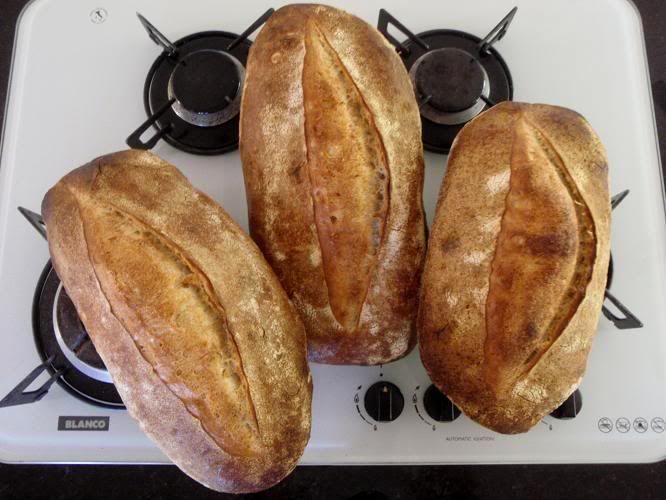
[b]SP's Country Sourdough[/b]
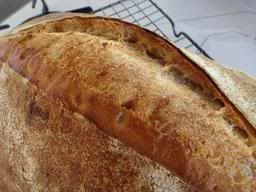
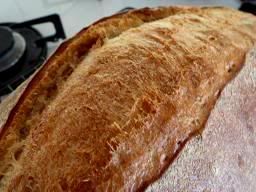
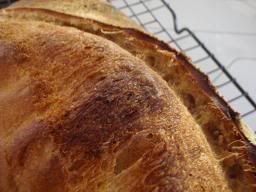
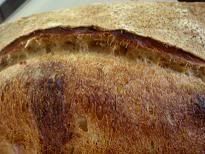
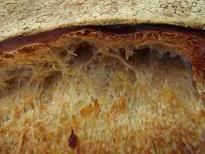
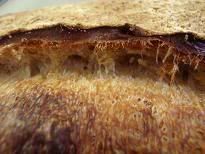
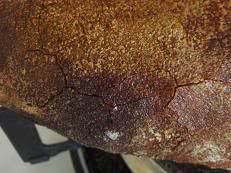


And let's slice them ...
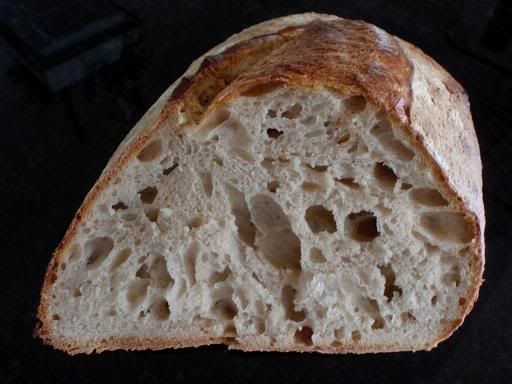
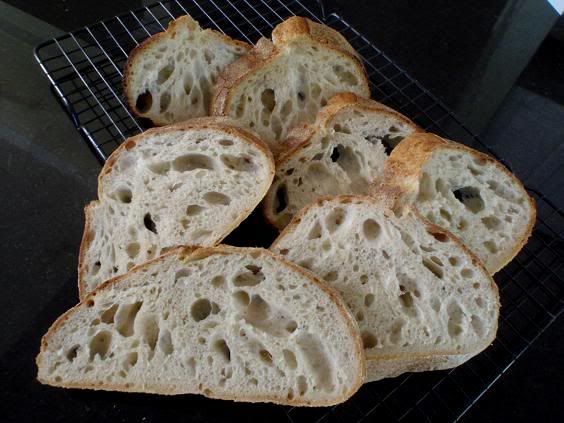
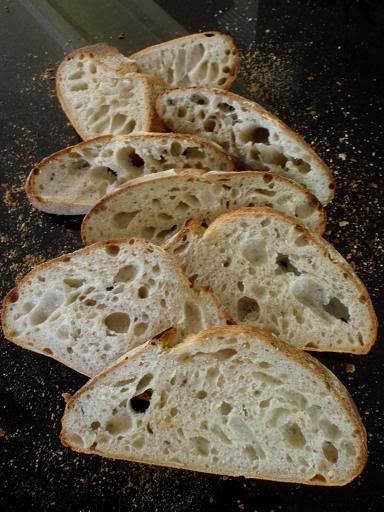

Now I found something ...
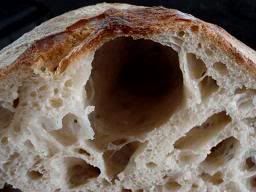
And this ...

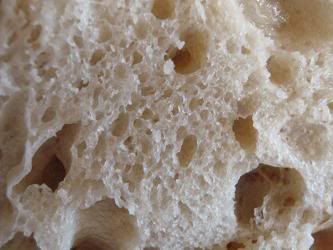
Lovely crumb to me but this is slightly on the dense side and [b]gummy[/b], why?
A wake-up call:
I recall when I was mixing my starter in the water for the final dough, I felt tiny little lumps of dough in my hands but I was unable to break them up because they were too many. I used a trick that I learned from making custard when there were lumps - by pushing the starter through a sifter, I managed to get rid of most big lumps, but there were still many very tiny ones. I got tired of trying to get rid of them, so I proceeded as normal. Those lumps would most likely have been formed during the 2 hour final levain expansion (see my post [b]here[/b] for details of Chad Robertson's sourdough timeline) - I did not mix the starter [b]thoroughly[/b] with the flour and water. And these lumps, however small, became the gummy part of the crumb! (I may be wrong but that's what I think it was.)
A myth: The longer the fermentation, the better it is for the sourdough. No, it depends on how time is spent, not how much time there has been.
With this sourdough, I learned something new. What happened was when I was trying to get rid of the lumps, my hands were stirring the starter in the water for quite a long time (15 to 20 minutes at least). I had never seen so many bubbles appearing in the water as if [b]all[/b] of the wild beasties were woken up from their sleep and were doing their morning exercises. This would not have meant anything to me, had it not been the fact later on that the fermentation seemed to have advanced in quite a fast pace even though the dough temperature was under 20C / 68F. (I wish Debra of the Frankendough could help me out here.)
Anyway, with the fermentation kicking along, I decided I wanted to do an experiment, and that is, to really work the dough with my stretch & folds in such a way as to really build the dough strength. I dipped both of my hands in water (to prevent sticking) and, with one hand pressing the centre of the dough, the other hand grapping a corner of the dough and folding onto itself, I stretched & folded the dough quite [b]vigorously[/b] for at least 30 to 40 times at each set of S&F's until the dough felt [b]elastic[/b]. I did 3 sets of S&F's within one and a half hours and within that time the dough expanded quite a lot. In normal circumstances I would have done a 4 hour bulk fermentation as in my post of Chad Robertson's country sourdough; but in this instance, I decided one and a half hours were enough (the dough temperature stayed under 20C). I divided the dough into three pieces and pre-shaped them twice as they were very soft and even though I pre-shaped them to very tight balls each time they relaxed and spread out completely. I shaped them to tight batards and only proofed for half an hour, compared to 2 hours previously when I did my Chad Robertson's. Retardation was only 9 hours.
This morning before I baked them, the doughs were as flat as pancakes, but in the oven, they rose like hills:
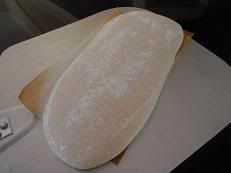

What I learned in this bake is that the dough strength (built up from the vigorous stretch & folds) helped in the volume (the oven spring, the open crumb, etc).
Time for some food,
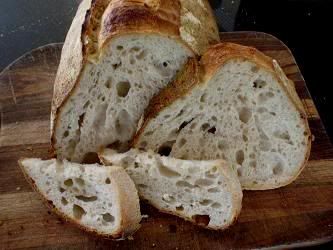
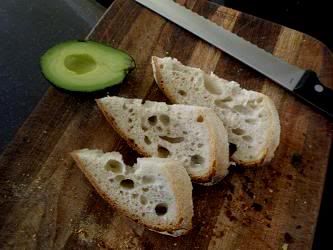
And pack up the rest,
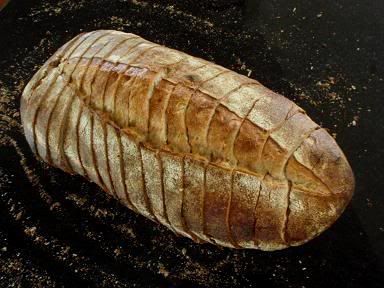
Shiao-Ping
p.s. The minor variations I made in the formula here compared to the one in My Imitation of Chad Robertson's Country Sourdough were: (1) 72% hydration; (2) 5% of total flours in rye flour; and (3) total dough weight 3 kg.
- Shiao-Ping's Blog
- Log in or register to post comments
in your photos and descriptions of your baking adventures, the fun you have shines through. That feeds my Baking habit just as much as your technical explorations. For that I send Double Thanks.
Dave
I blushed.
Beautiful as always, Shiao-Ping. Well done.
Thank you.
indeed! And one for our stomach as well!
Beautiful, Shiao-Ping.
Larry
After I sent that post, I thought it was presumptuous of me to say that the pictures were a "feast." Then, I thought to myself, no worries, we are home bakers and free to do anything we like within reason. Still, sometimes I wonder if it is possible to have a private blog to avoid embarrassment.
Beautiful loaves as always! Great explanations! Now I know why my bread is sometimes gummy. I thought it was due to underbaking. Thanks for your hard, fun (and funny) work.
Salma
The other day I made a Fresh Peas and Spinach Sourdough. You know these days you get frozen peas and frozen spinach quite easily from supermarkets. I often stock them in my freezer but I always love it when I am able to get the fresh ones from the market. We are city people and fresh markets are a novelty to us. When I am able to get the fresh snow peas (in their husks), I would announce it to the whole family - meaning we will have something special at the dinner table that night. Fresh peas to me are simply luxury; restaurants get them and people normally just get frozen ones.
Anyway, this Fresh Peas and Spinach Sourdough had all the promises of a great sourdough - except that it was underbaked!! I put on my timer and when it beeped, my children turned the oven off (the timer was supposed to be a reminder to check on the bake)! We had unexpected guests on that Sunday morning and I was busy attending to our friends.
As it turned out, I [b]double-baked[/b] the loaf, trying to cook my way out of the [b]gumminess[/b] of it due to the [b]underbaking[/b], but it didn't work. It had made it worse. The gumminess stayed. It was one failed Fresh Peas and Spinach Sourdough!
Once the loaf is [b]underbaked[/b] (and the temperature of the loaf has dropped to room temperatuare), my experience has been that it is not possible to change the gumminess.
Polly our dog is a happy recipient.
Your pictures are beautiful, as always, Shiao-Ping. From reading your whole story, I'm going to guess your bread was the victim of a starch attack. If you have Hamelman's Bread, you can read more on page 47, but here's the core of it:
Let's take a closer look at the factors in play here:
1. It starts with the extra aeration introduced during mixing in the attempt to work out those lumps. (It appeared that the yeast were invigorated, because they probably were :-) Extra aeration continued with all those stretch-and-folds throughout the bulk fermentation. Remember from our previous discussion that yeast produce 3x as much CO2 per sugar molecule in their respiratory mode. They also produce up to 38 ATP of energy vs. only 2 during fermentation, so they can reproduce themselves much faster as well. More yeast, producing copious amounts of gas, made your dough rise quicker than usual, short-changing fermentation. (Also, the extra aeration may have increased oxidation, which also speeds dough develpment.)
2. Shortened fermentation time short-changed acid development---not enough acid to sufficiently slow amylase activity, should the dough reach that magic temperature range of accelerated activity. The slacker-than-normal dough is another clue that the acids maybe weren't accumulating as usual. (But, you didn't comment on how the bread tasted.)
3. Then came the straw that broke the cammel's back---the oven was shut off at a critical time, allowing the dough to enter the critical temperature range for starch attack, and remain there too long, giving the enzymes more time to do their damage.
Well, that's my theory anyway ;-)
-dw
Your points are very clear. Thank you very much for the explanation. For a home cook, rye flour is not easy to do well.
I think I confuse people with too many bakes in one post. The no-knead sourdough sandwich loaf in the comments section has 30% rye, but the fresh peas & spinach sourdough has no rye, nor does [color=red]the subject sourdough[/color] in this post. But your points are all valid and great as a knowledge build-up for home cooks. Thank you for taking the time to write.
Shiao-Ping
Yep, I realized only after I posted that, that these were two different breads, but I hadn't gotten back to edit it yet. So, 1 & 2 above apply to the bread in this thread, and 3 applies to the pea & spinach sourdough on the other.
The point I failed to make about the Hamelman quote is that wheat flour is not exempt from starch attack in your case, because turning off the oven in the middle of the bake gave the enzymes plenty of time to do their work. Even though the temperature for gelatinization is higher for wheat than for rye, chances are good that your bread would have acheived that. If you have Peter Reinhart's Whole Grain Breads, this is actually the principle for making a mash---gelatinizing a portion of the wheat flour with boiling water, then holding it in a specified temperature range for a period of time to increase the free sugar content by enzyme action.
But, starch attack isn't the only thing that can cause gumminess :-)
-dw
I am aware that wheat flour is not exempt from starch attack. What I've found really interesting from your earlier remarks is that turning off the oven half way through baking actually contributed in a large way the gumminess of my fresh peas and spinach sourdough.
Shiao-Ping